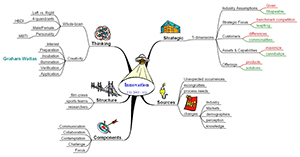 This image is a simple mindmap I created several years ago for an innovation project I led.
This image is a simple mindmap I created several years ago for an innovation project I led.
It does a good job of capturing a lot of information in a simple format. The actual map contained links to several of the sources, which made it even more useful, but it also had a stong visual impact on the audience, and helped us focus on what was important.
Today, looking back at it several years later, the map immediately brings to mind all the key components of innovation we discussed — many of which I would have long since forgotten otherwise.
That’s one of the great advantages of mindmaps — the ability to trigger related thoughts and quickly bring to the surface ideas that might otherwise be forgotten or overlooked.
Mindmapping is a bit like brussel sprouts — people tend to love them or hate them. But what I find mostly is that some people hate creating them, they feel the mindmap process is too cumbersome or freeform. Very few people actually hate a well-done, informative map unless it is too complex, or too crowded to be easily grasped.
For me, mindmaps don’t fit every circumstance, and they don’t suit every purpose. I use them when appropriate. They are terrific at capturing lots of information but, if not groomed and trimmed, can get a bit unwieldy.
Today I use an online mindmapping tool called Mindomo. If you’re interested in trying mindmaps to spur your thinking or memory give it a try.